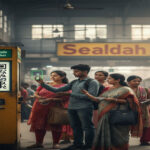For commuters rushing through Kolkata’s Sealdah station, one of India’s busiest suburban railway hubs, the UTS QR code has quietly become a lifeline. Within seconds, it allows a traveler to pull out a smartphone, scan a square of black-and-white patterns pasted near a pillar or counter, and generate a paperless ticket inside the Unreserved Ticketing System (UTS) app. That single interaction saves valuable minutes—sometimes more—otherwise spent in winding queues at unreserved ticket counters.
But the search intent behind “Sealdah UTS QR code” is less about its existence and more about how it truly works, why it was introduced, what problems it solves, and what limitations or risks it carries. Within the first few seconds of using it, passengers discover the sheer utility of the system: automatic station recognition, digital payments, and instant tickets. Yet beneath that convenience lies a complex digital experiment unfolding across Indian Railways—one involving behavioral change, security trade-offs, rapidly evolving policy, and debates around fairness and accessibility.
This long-form investigation takes readers inside the mechanics of the Sealdah UTS QR code—its operations, misuses, the frustrations of geo-fencing, the push for dynamic QR codes, and the broader ambitions of rail digitalization. Along the way, expert voices provide clarity, firsthand accounts, and direction for the future of ticketing across India.
Origins and Evolution of QR-Based Ticketing
The QR-enabled UTS model began as Indian Railways’ answer to overcrowded counters and the limitations of vending machines. Its early iterations required users to manually type station names. While helpful, this created friction—wrong spellings, unfamiliar station codes, and the learning curve of the app itself.
Sealdah, with its intensity of suburban traffic, quickly emerged as a proving ground for QR enhancements. Static QR codes pasted around the concourse enabled instant origin detection, cutting booking time dramatically. Paired with UPI payments and a digital wallet option (R-Wallet), the system gradually found its footing among daily commuters who valued speed.
Why Sealdah Matters in This Experiment
Sealdah is not just another suburban station. It is a living stress test of how digital ticketing performs under peak pressure. Every day, commuters representing a wide spectrum—office workers, students, small-business owners, migrant laborers, and occasional travelers—move through its platforms.
| Factor | Why It Matters |
| High Footfall | Extreme peak load tests system reliability and adoption. |
| Diverse Users | Measures whether digital tools work across economic and tech-literacy groups. |
| Limited Counter Capacity | Necessitates alternative channels for ticketing. |
| Frequent Short-Distance Travel | Ideal for quick, repeat digital ticketing. |
| Revenue Sensitivity | Any misuse scales quickly due to volume. |
In Sealdah, even shaving seconds off a ticketing transaction translates into profound crowd management wins. The QR experiment helps the railways understand whether digital tools can sustainably reduce queues without excluding those unfamiliar with smartphones.
How the Technology Works—And Where It Stumbles
Static vs. Dynamic QR Codes
Sealdah’s static codes are easy to deploy but vulnerable to abuse. Anyone can capture the code and reuse it elsewhere. While the UTS app has safeguards—primarily geo-fencing—users report inconsistent enforcement.
Dynamic QR codes, which refresh regularly, would mitigate these concerns, but they require digital displays, uninterrupted power, and seamless backend coordination. For a heritage-era station with large open spaces, retrofitting is not trivial.
Geo-Fencing Complexities
The UTS app uses phone GPS to determine if the passenger is at a permissible location. In theory, this keeps users from booking tickets after stepping onto the platform. In practice, GPS often behaves erratically near dense concrete structures or overhangs.
Commuters have reported situations where:
- they were blocked despite being outside the station,
- they needed several attempts to get correct GPS locks,
- emergency or last-minute travel became difficult.
The intent is right, but execution remains imperfect.
Ticket Encryption and Verification
Each generated UTS ticket contains an encrypted QR code. Ticket examiners use handheld devices capable of reading this encrypted data offline. This ensures verification even when connectivity is poor—a crucial requirement in rail environments.
This encryption also means screenshots or copied QR codes are generally ineffective, promoting system integrity.
Voices from the Ground: User Experience and Sentiment
Even without formal studies, a clear pattern emerges from commuter feedback:
Praise
- The process is dramatically faster than counters.
- Payment flexibility—especially UPI—reduces dependence on cash.
- Auto-filling the origin station eliminates errors.
- It is lifesaving during rush hour when queues overwhelm the concourse.
Frustrations
- GPS-based restrictions sometimes prevent legitimate bookings.
- Static QR codes are too easily circulated online, inviting ambiguity.
- New users struggle with onboarding, particularly during app updates.
- Elderly or low-tech commuters feel left behind.
A student commuter summed up the reality poignantly: “The QR system works beautifully—until the moment you need it most and the GPS refuses to cooperate.”
Institutional Responses and Policy Adjustments
Indian Railways recognizes the dual challenge of promoting digital convenience while preventing revenue leakage. Within this tension, multiple reforms are under discussion:
- Dynamic QR Deployment: High-risk stations like Sealdah may shift to dynamic QR codes to reduce misuse.
- Awareness Campaigns: Posters, announcements, and digital screens may guide new users more clearly.
- Geo-Fence Calibration: Engineers are exploring whether the radius can be adjusted without compromising security.
- Strengthening TTE Tools: Enhancements to handheld devices can further streamline verification and detect anomalies.
- Usage Targets: Internal goals for digital adoption may shape funding and infrastructure upgrades.
These initiatives show Indian Railways’ evolving stance: digital ticketing is no longer an experimental sideline but a core component of future operations.
How UTS QR Booking Stacks Up
| Mode | Strengths | Weaknesses |
| Counter/ATVM | Familiar, accessible to all | Crowding, cash issues, slow |
| UTS Manual Booking | Fully digital, flexible | Requires typing station names |
| UTS QR Booking | Fastest, auto-fills station | Static QR misuse, GPS errors |
| Season/Platform QR Tickets | Convenient repeat use | Needs regular renewals |
This comparison underscores the QR method’s prime advantage: speed. But it also reveals the structural vulnerabilities of static QR codes and dependence on mobile accuracy.
Ethical and Accessibility Dimensions
Fraud vs. Inclusion
While combating misuse is essential, policies must not inadvertently exclude those who lack smartphones, data plans, or the ability to navigate digital interfaces.
Privacy
Continuous location access raises justified questions. Although the app uses location only during booking, the perception of surveillance can erode trust.
Revenue Integrity
A small leak in a high-volume system becomes a significant loss. Balancing trust and enforcement is delicate.
Digital Equity
Any transformation in public infrastructure must ensure that the least digitally empowered citizens are not silently penalized.
Wider Implications for India’s Public Digital Infrastructure
The Sealdah experiment reflects India’s broader digital push: a blend of ambition, improvisation, and learning by doing. The UTS QR system aligns with national trends in:
- Cashless payments
- Smart governance
- Data-driven service optimization
- Eco-friendly paper reduction
- Scalable public digital utilities
If the model stabilizes, it could inform bus systems, metro expansions, and other transport forms nationwide.
Key Takeaways
- The Sealdah UTS QR code dramatically speeds up unreserved ticket booking.
- Static QR codes introduce misuse risks, prompting discussions around dynamic alternatives.
- Geo-fencing helps maintain integrity but often frustrates legitimate commuters.
- Encrypted QR tickets allow offline verification by examiners, boosting security.
- The system is promising but requires upgrades to balance convenience, fairness, and trust.
Conclusion
The QR code taped to a column at Sealdah station may look ordinary, but it represents a pivotal technological shift in India’s railway ecosystem. It offers a taste of what digital public infrastructure can achieve: speed, simplicity, and a reduction of everyday frictions. At the same time, it exposes the vulnerabilities inherent in transitioning from analog systems to digital ones—where fairness, security, and accessibility must all be actively engineered.
Sealdah’s adoption of the UTS QR code is not merely a local convenience; it is a case study in how institutions modernize. It highlights the need for dynamic improvements, inclusive design, and constant vigilance against misuse. If those lessons are absorbed, Sealdah could help shape the blueprint for India’s next generation of public transport ticketing—one that is not just faster, but also more equitable, resilient, and trusted.
FAQs
1. What exactly does the Sealdah UTS QR code do?
It allows commuters at Sealdah to scan a station-specific QR code through the UTS app, automatically setting the origin station for quick digital ticket booking.
2. Do I need to be physically present at Sealdah to scan it?
Yes. The system is designed for on-site scanning, and geo-fencing prevents improper remote bookings.
3. Why does the UTS app sometimes block QR bookings?
GPS restrictions may detect that you are too close to the tracks or inside a restricted zone, even if you are at the correct location.
4. Can the static QR code be reused?
It can be photographed, but proper ticketing requires real-time GPS validation and app-based verification. Still, misuse attempts have prompted discussions of dynamic QR codes.
5. How do ticket examiners verify digital tickets?
They scan the encrypted QR on your digital ticket with handheld devices that can validate information even without network connectivity.







